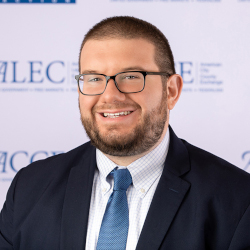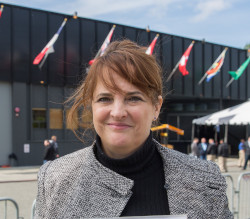Posted by Elena del Valle on July 25, 2022

Thomas Savidge, research manager, Center for State Fiscal Reform at American Legislative Exchange Council
Photo, report: American Legislative Exchange Council
A podcast interview with Thomas Savidge, research manager, Center for State Fiscal Reform at American Legislative Exchange Council (ALEC), is available in the Podcast Section of Hispanic Marketing and Public Relations, HispanicMPR.com. During the podcast, he discusses unfunded public pension liabilities in the 50 States (see ALEC 2021 35-page report on state pension funds: Unaccountable and Unaffordable) with Elena del Valle, host of the HispanicMPR.com podcast.
Tom researches and writes on state tax and fiscal policy, applying knowledge learned in the classroom and working in the policy world.
To listen to the interview, scroll down and click on the play button below. It is also possible to listen by looking for “Podcast” then select “HMPR Thomas Savidge” and download the MP3 file to your audio player. You can also find it on the RSS feed. To download it, click on the arrow of the recording you wish to copy and save it to disk. The podcast will remain listed in the July 2022 section of the podcast archive.
Posted by Elena del Valle on April 22, 2020

Aline and the Blue Bottle
Photos: Damonza (book cover), Farshad Khoshroo (author photo)
Carolina Ugaz-Moran, a native of Spain raised in South America and the United States with degrees in biochemistry and creative writing from the University of Wisconsin, spent ten months spread over 15 years writing Aline and the Blue Bottle, her first book. The 303-page softcover book published in 2019 includes Spanish and Quechua words, a map at the beginning as well as a page of Spells and a glossary at the end. Her target audience? Children eight to twelve years old and older.
“The cover depicts Aline standing on the House of Haunted Gargoyles facing her future, a magical floating castle with mysterious creatures flying around,” the author said by email when asked about the cover art. “She is at the entrance of a forest, with vines that surround her and behind her are her two loyal and close magical friends carrying the blue bottle. The cover also holds secrets (just like within the book).”
She went on to explain, “The title highlights Aline, her adventure, and her first quest to find the blue bottle and save many worlds. It also shows strength, courage,passion, and empowerment – in this case for a girl, depicting mysteries and magic which Aline and her friends will have to face together.”

Carolina Ugaz-Moran, author, Aline and the Blue Bottle
When asked why she included Quechua she said, “I think the more exposed we are to languages as children, the more neurons we connect and the better we can develop the ability to become multilingual, so why not add Quechua and Spanish! But for me, it is more than learning a new language, it is about understanding a culture and exposing oneself to the abundance fountain of knowledge that each language provides.
Also, a few years ago, I found out that even though several people can speak Quechua (8-10 million people) very few people can actually read and write it due to the lack of printed material in Quechua. There have been efforts from the Peruvian, Ecuadorian, and Bolivian governments to introduce the language as an intercultural bilingual education; however, some indigenous people in each of these countries are having their children study in Spanish for the purpose of social and economical advancement. I thought I tried to help out a little plus I can learn on the way. Fun fact: there are about 45 varieties of Quechua which are all classified as separate languages and in addition, there are several dialects.”
When asked if her biochemistry studies help her or play a role in the project she said, “Yes, as well as my love for science and nature. This can be seen in several places. The chimera twins. They are powerful sylph sisters who have an important role in the book series. A chimera is a single organism that contains two sets of DNA with the code to make two separate organism. Simply put, it is an organism made up of cells from two or more different individuals.
The explanation of magic and how it flows, it somewhat reflects the states of energy as well as the law of conservation of energy. The blue and red stars and how from earth, the cooler stars appear red, and the high temperature stars appear blue. The symbiotic relationship between sharks and remora fish, I am an animal lover and I am looking for ways for people to admire and be kind to even the scariest of animals.”
She is working on the second book in the Aline series. It will be called Aline and the Kron Queen.

Click to buy Aline and the Blue Bottle
Comments:
Filed Under: Books
Posted by Elena del Valle on August 19, 2019

Tiffany Finck-Haynes, program manager, Friends of the Earth

Lisa Lindsley, capital markets advisor, SumOfUs
Photos: SumOfUs, Friends of the Earth
A podcast interview with Tiffany Finck-Haynes, program manager, Friends of the Earth, and Lisa Lindsley, capital markets advisor, SumOfUs, is available in the Podcast Section of Hispanic Marketing and Public Relations, HispanicMPR.com. During the podcast, they discusse bee health and pollinators with Elena del Valle, host of the HispanicMPR.com podcast.
Tiffany leads the organization’s work to eliminate toxic pesticides and advance a sustainable and just food system to protect people, pollinators and the planet. She leads federal, state, local policy and marketplace campaigns aimed at reforming industrial agriculture. Prior to joining Friends of the Earth, she worked as a community health organizer at Many Languages One Voice, running campaigns to improve equitable access to affordable, culturally and linguistically appropriate health-related information, services, and care for nail salon workers and day laborers.
After getting her start on Wall Street, Lisa’s 33-year career in finance has taken her from the microfinance industry to the United States labor movement. She has lived in Brazil, Argentina and Mexico and is fluent in Spanish and Portuguese. Prior to joining SumOfUs, Lisa was director, Capital Strategies American Federation of State County and Municipal Employees (AFSCME). She led the effort to remove Jamie Dimon as the board chair of JPMorgan Chase, helped pass the Dodd-Frank Act, and pioneered shareholder initiatives around American Legislative Exchange Council (ALEC) and human rights. Lisa left her position as a managing director, Latin American Corporate Finance Division, Bear Stearns in 1995 to enter the microfinance field.
To listen to the interview, scroll down until you see “Podcast” on the right hand side, then select “HMPR Tiffany Finck-Haynes, Lisa Lindsley” and click on the play button below or download the MP3 file to your iPod or MP3 player to listen on the go, in your car or at home from the RSS feed. Some software will not allow flash, which may be necessary for the play button and podcast player. If that is your case, you will need to download the file to play it. To download it, click on the arrow of the recording you wish to copy and save it to disk. The podcast will remain listed in the August 2019 section of the podcast archive.
Posted by Elena del Valle on October 11, 2018
2024 podcast guest list in alphabetical order:
Howard S. Dvorkin, C.P.A., chairman, Debt.com
Clement Feng, vice president of Product Management, Briggs & Stratton Energy Solutions
Brooke Goff, CEO, Goff Law Group
Maria Rodriguez, owner, Vanguard Communications
2023 podcast guest list in alphabetical order:
Michael R. Agostino, R.ph., CEO, Network of Advanced Specialty Healthcare (N.A.S.H.)
Timothy Baker, C.F.A., founder, Metric Financial
Jennifer Chesak, author, The Psilocybin Handbook for Women
Fred Cohen, M.D., headache specialist, Mount Sinai Medical System, New York City (migraines)
Fred Cohen, M.D., headache specialist, Mount Sinai Medical System, New York City (sleep and migraines)
Barbara C. Cruz, co-author, The Cuban Sandwich
Jeff Houck, co-author, The Cuban Sandwich
Andrew Huse, co-author, The Cuban Sandwich
Stephen M. Kohn, author, Rules for Whistleblowers
Lara Pizzorno, lead author, Healthy Bones Healthy You
Miriam Schulman, author, Artpreneur
David Waltner-Toews, author, On Pandemics
2022 podcast guest list in alphabetical order:
Mathieu Champigny, group chief executive officer, CoCreativ
Nazeera Dawood, CEO, Vendorship Inc.
Ivan Estrada, author, Brand With Purpose
Talia Henkle, Ph.D., cancer content creator, Sparrow
Jackie Lange, CEO, Panama Relocation Tours
Roger Osorio, author, The Journey to Reinvention
Andrew Ross, author, Sunbelt Blues
Thomas Savidge, research manager, Center for State Fiscal Reform at ALEC
Dina Rubio, co-owner, Don Ramon
Filmmaker Claudia Sparrow
Stanley Wong, co-founder, DistroScale
2021 podcast guest list in alphabetical order:
Barry Alexander, CEO, Aquiline Drones
Erika Benson, co-owner, Gokce Capital LLC
Erika Benson, co-owner, Gokce Capital LLC, part two
John Dunn, author, Drying Up
Javier Folgar, founder, Toa Waters
Eric Goulder, M.D., founder, Heart Attack Stroke Prevention Center of Central Ohio (HASPC)
Michael Harari, Ph.D., associate professor, Management Programs Department, Florida Atlantic University
Tony Hereau, vice president of Cross-Platform Insights, Nielsen
John Incledon, president, Hisamitsu America
Robert Knight, P.h.D., director, Florida Springs Institute
Karla Legaspy, filmmaker, The Daily War
Jon Lieff, M.D., author, The Secret Language of Cells
Staci Reidinger, president, Reidinger Public Relations
Sofia Tafich, freelance journalist, WhoWhatWhy
2020 podcast guest list in alphabetical order:
Calvin Carter, CEO, Bottle Rocket – part 1
Calvin Carter, CEO, Bottle Rocket – part 2
Susan J. Douglas, author, In Our Prime
Torbjørn Ekelund, author, In Praise of Paths
Gary Dudney, author, The Mindful Runner
Marleny Gomez, realtor, HomeSmart
Zuhair Haleem, Ph.D. student, University of Florida
Bel Hernandez Castillo, CEO, Latin Heat Media
Engelina Jaspers, author, Marketing Flexology
Krista Jenkins, Ph.D., professor of Politics and Government, Fairleigh Dickinson University
Julie Kalabalik-Hoganson, PharmD, director, Pharmacy Practice, Fairleigh Dickinson University
Jenni Lehtimäki, Ph.D., senior researcher, Finnish Environment Institute
Shiva Nag Kompella, Ph.D., post doctoral research associate, University of Manchester
Gaby Lechin, senior vice president, Global Results Communications
Randy Pherson, author, How to Get the Right Diagnosis
Naibe Reynoso, founder, Con Todo Press
Hilary Topper, author, Branding in a Digital World
2019 podcast guests in alphabetical order:
Rana Adib, executive secretary, Ren21
Louis Bezich, author, Crack the Code
Todd Caponi, author, The Transparency Sale
Michele Colopy, program director, Pollinator Stewardship Council
Javier Delgado, founder, PeopleToo LLC
Katherine Eban, author, Bottle of Lies
Tiffany Finck-Haynes, program manager, Friends of the Earth
Lisa Lindsley, capital markets advisor, SumOfUs
Tom McMakin, co-author, How Clients Buy
Shital Mars, CEO, Progressive Care
Podcast guests from 2006 to 2018 are listed here.
Comments:
Filed Under:
Posted by Elena del Valle on February 15, 2010
By Martha Galindo
CEO and president, Galindo Publicidad Inc.

CEO and president, Galindo Publicidad Inc.
Photo: Martha Galindo
Press releases are a great way to get some coverage from media outlets, in any language.They’re also a great way to break into new markets, especially foreign language ones. That’s a strategy more companies are starting to adopt. There are thousands of non-English language media outlets, and they offer a great opportunity for companies to get their message in front of a new audience.
The non-English U.S. market can be substantial. According to recent reports there are 2,453 unique U.S. Hispanic media outlets, including more than 1,200 print publications, and more than 1,000 TV and radio outlets and shows. There are also twenty AP-style wire services and news syndicates. In some cases these are the only media serving a particular Hispanic community. Any company with a product that fits this market would do well to send press releases to these key outlets.
Here are 6 rules for success in sending press releases to Spanish language media outlets.
1. Make sure it is well-written. This is extremely important. The press release should be written in a newsy style — crisp, factual, with a quote or two from a spokesperson to spice it up. It should not have awkward phrases, misspelled words, or bad grammar.
2. Follow the standard press release format. This means you use the third person, and an inverted pyramid style (the most important information and quotes come at the top). Always give dates, locations, and times in the beginning of the release. The final paragraph should summarize the release, and at the bottom you should have the information (name, phone number and email address) of the person you want the press to contact.
3. Allow for word expansion. Spanish, as well as Portuguese, French, and Italian, for example, need about 20% more words than English to say the same thing. Plan for your press release to be longer in these languages, and be considerate with the space available.
4. Make sure it is translated appropriately. This is also very important. If you send a press release that is poorly translated it will mean the media outlet has to edit it, and not too many editors these days have the people allocated to do this properly, the time nor the desire to rewrite press releases. On the other hand, if the media outlet is not familiar with your industry, and you are letting them translate the content, you may run into inaccuracies getting printed without you having the chance to verify it. If there are clumsy expressions or phrases that the audience won’t understand, the press release will probably get thrown in the wastebasket. You should also avoid translations that are specific to one region or dialect, because they may not apply to a broader audience.
5. Make it newsworthy. The goal of a press release is to get publicity for your company. You have a better chance of achieving this if you can link the release to something that is important to the community you’re trying to reach. If you have a promotion that is planned, you may get more mileage out of it if you time it to coincide with a national festival or holiday for the ethnic group you’re targeting. Investigate well the meaning of such celebration to your audience. Many times, Cinco de Mayo for example, has been confused with Independence Day and it gets more than laughs from many Mexicans living in the U.S.T his is something that a good translation company can help you with. Do not let anyone laugh at your brand.
6.Tap into the translator’s expertise, and allow them to go beyond foreign words on the page. You do not have to panic nor reinvent the wheel every time you need to address the US Hispanic Market in Spanish. Let the qualified translators with expertise in advertising know how creative you want them to be. They are communication bridges, and their knowledge about the culture you’re communicating with is very valuable to help you transcreate your ads, adapt your releases and tweak your message.
Don’t forget that the audience for foreign language media is in the millions. Press releases are a great way to reach any audience and test the waters — if you do them the right way.
Martha E. Galindo, CEO and president of Galindo Publicidad Inc., holds a Master of Arts in Communications, is an ATA certified translator and a winner of multiple awards. She blogs about Translation Services, the U.S. Hispanic Market, and Globalization issues. Her company provides voiceovers and multilingual translations of brochures, websites, surveys, ads, press releases, manuals, catalogs, telephone scripts, etc.
Comments:
Filed Under:
Posted by Elena del Valle on June 13, 2008

The Boys from Dolores book cover
Photo: Stephen Lewis
In The Boys from Dolores Fidel Castro’s Schoolmates from Revolution to Exile, a recently published book (Vintage, $15.95), Patrick Symmes tells the story of some of Cuba’s privileged boys from days gone by. Fidel Castro and his brother Raúl are among the many boys that attended the Colegio de Dolores, a private school on the island, in the 1940s.
In the 352-page book, the New York author describes the story of a group of boys he believes were an essential part of Cuba’s political and social history. The boys, chosen from among the most affluent and ambitious families in eastern Cuba, were groomed at the school Colegio de Dolores for achievement and leadership.

Author Patrick Symmes
According to promotional materials, Symmes tracked down dozens of schoolmates and shares some of their stories in the book. He includes their time at the Colegio and the effects of the revolution on their lives. The boys, he tells the reader, were trained by Jesuits for dialectical dexterity and the pursuit of absolutes.
He goes on to describe Fidel Castro in his formative youth, as an adolescent in the Colegio and in the streets of Santiago, the province where the school was located. Symmes traces the years in which the revolution was conceived and its evolution. He also describes the changes it produced in Santiago and in the lives of the boys. With Symmes’ help the reader can follow the boy’s life through the 1960s, as many left Cuba and a few stayed behind.
Symmes sets out to provide readers with a tour of the world that gave birth to Fidel Castro and the island his Cuban Revolution left behind. It is described as an “eye-opening portrait of Cuba in the twentieth century.” Symmes, a resident of New Yok, is the author of Chasing Che. He writes for Harper’s, New York, Outside, and Conde Nast Traveler magazines.

Click here to buy The Boys from Dolores
Comments:
Filed Under: Books
Posted by Elena del Valle on August 31, 2006
By Tony Malaghan, CEO, Arial International

Tony Malaghan, CEO, Arial International
Photo: Tony Malaghan
In today’s highly competitive marketplace, call centers are taking steps to provide best-in-class service. If your company is servicing multilingual customers, it is reasonable they would expect to receive excellent service in whatever language they speak. For those servicing US Hispanic customers, only the largest or most specialized companies are able to staff call center representatives to handle all their calls in one language. Most bilingual call center customer service, telemarketing and collection agents in the US handle both English and Spanish calls randomly throughout the day so that companies can meet service level goals, schedule enough agents during peak times and optimize the use of inbound and outbound call center technology. Therefore, these call center agents must be able to competently communicate and be proficient in both languages in the specialized vocabulary of your industry.
Before we begin to address Business Spanish Call Center Certification, let’s first look at one of the most common issues raised by call center managers when talking about the US Hispanic market: call duration, which highlights one of the many differences between this market and the general market. Most managers are aware that Spanish calls tend to last longer, but few are aware of the variety of reasons this occurs:
1. US Spanish speakers are likely to ask more questions about basic steps and processes than English speakers. This is because they may not be as familiar with the products/services and jargon used in the US.
2. English is a more precise and concise language than Spanish. Spanish requires more words to communicate the same idea. In our experience as many as 20 to 30% more words are required to describe business concepts or processes than would typically be used in English.
3. Spanish conversations between people from different backgrounds can complicate business communication. More than 20 countries in the world speak Spanish using a wide variety of pronunciation, accents, dialects and vocabulary. Customers and employees may come from different backgrounds where even simple words such as “to pay” have different meanings from country to country.
4. Call center representatives often spend time translating letters and billing statements from English to Spanish or re-translating poorly written documents. Many companies send all written correspondence in English. This requires employees to spend their valuable time on calls translating or clarifying the content of written documents.
5. Most bilingual employees do not receive in-language industry-specific training. Many bilingual call center representatives’ understanding of Spanish is limited to day-to-day activities, which is very different from conducting a business conversation. Companies must teach bilingual employees how to use accurate vocabulary and in the correct context for their field in English and Spanish.
These are just a few reasons why your bilingual operation differs from your general market operation. So how do companies assure their call centers and call center representatives provide outstanding service in either language and at the same time meet business goals? Many call centers are implementing a Business Spanish Call Center Certification Program to attain “Best Practices”. Certification programs cover all aspects of a business operation, including Management Practices, Technology, Call Monitoring, Measurements, Hiring and Training.
Due to the content limitations of this article, I will discuss one or two of the areas under each of the headings above:
Management Practices
Diversity Training – Bilingual personnel receive Cultural Diversity/Awareness Training to help them understand the cultural nuances of doing business with people from different cultures. This is particularly relevant to the US Hispanic market given the diverse ethnic origins of the group labeled “US Hispanic”.
Handling Escalated Calls – There should be at least one on-site Spanish-speaking Supervisor scheduled per shift to handle escalated calls. Nothing will frustrate a customer more than the inability to effectively communicate to a supervisor about an escalated issue with a product/service or customer service agent.
Technology
Flag on “Spanish Language Preferred” Accounts – Many US Hispanics have a preference for speaking in Spanish. This is particularly the case with high value products/services or where important issues such as personal finances are concerned.
Spanish Language Inbound Voice Response Unit – Translate your entire VRU script into Spanish. Only having some options in Spanish can frustrate those customers who prefer to speak Spanish. Translating the entire VRU script will demonstrate to your US Hispanic customers that you are committed to serving them.
Call Monitoring
Spanish Language Calls are Monitored by a Certified Spanish Speaking Supervisor – A minimum of five Spanish language calls per agent per month should be monitored, evaluated, scored and feedback and coaching provided to the agent.
Calls are Recorded as a Regular Procedure – Spanish language calls are recorded and used for training, evaluations and coaching. These are especially useful to provide feedback to agents during their performance evaluations.
Measurements
Hold Time – Hold time for Spanish-speaking inbound customers is the same as or less than for English language customers.
Incentives – Spanish speaking agents are eligible for incentives based on the calls they handle and are not penalized for handling Spanish language calls.
Hiring and Training
Bilingual Certification Program for Employees – Employees complete a “Business Spanish” certification program that includes: a pre-training assessment, a training seminar, a detailed, industry-specific glossary, testing and a post-training certification assessment.
1. Pre-assessment of verbal communication skills
Telephone agents are assessed on their Spanish language proficiency. Pronunciation, basic grammar, verb conjugation, proper use of feminine and masculine articles, sentence structure, vocabulary and use of formal business communication are some of the areas assessed. Agents are tested and scored based on their language proficiency. Those that “pass” the assessment are recommended for “Business Spanish” training. Those that do not meet the minimum requirements are not recommended to handle Spanish language calls and are encouraged to further study the language.
2. “Business Spanish” Training
Business Spanish training, conducted in Spanish by a native speaker, is customized for each industry and each job function. Written materials and instruction are provided in Spanish. The three primary objectives of the training are:
1. Refresh participants on the proper use of formal business communication rules in Spanish by using true-to-life examples and situations that call center representatives encounter every day;
2. Improve and expand the vocabulary, industry-specific terminology and phrasing that the agents require to communicate effectively; and
3. Reduce call duration and the number of calls escalated to supervisors.
3. Written and Verbal Communication Testing
After the training session agents are tested on the skills and terminology they learned to ensure they retained and can correctly apply the new skills and vocabulary. Depending on the level of Spanish proficiency required, agents receive testing as verbal-only, written-only or a combination of the two. The agents that pass the test with a score of 80% or better are eligible for certification.
4. Call Monitoring
The final step is immediately conducting call monitoring of live interactions between agents and customers to confirm that agents are, indeed, applying their newly learned skills. Usually about five calls, or 30 minutes of monitoring per agent, are sufficient to recommend eligibility for certification.
Typically, as with most business decisions, deciding to certify your call center comes back to ROI. In part two of this article I will address some common questions and the resultant benefits of Business Spanish certification of your call center.
Arial International, in business since 1992, is a multicultural, multilingual firm that assists companies in targeting and retaining US Hispanic customers. The firm is recognized as the leader in delivering “Business Spanish” services including language assessments, translations, bilingual training, certification programs, consulting projects and E-Learning. The firm has trained over 25,000 professionals in 30 countries with an emphasis in the US and Latin America.
© 2006. Arial International.
This article has been printed with permission from Arial International.
For more information please call 888-446-2331, send an e-mail to info@arialinternational.com or visit us on-line at www.arialinternational.com.
hosted auto dialer system
Hispanic Marketing and Public Relations book

To purchase a copy of the Hispanic Marketing & Public Relations book featuring “Effective Translations,” a chapter by Tony Malaghan, CEO, Arial International visit the HispanicMPR.com Resoures Section
Comments:
Filed Under:
Posted by Elena del Valle on May 19, 2006
By Juan Manuel Colome, founder and president, Infoseek Technologies Inc.

Juan Manuel Colome, founder and president, Infoseek Technologies Inc.
Photo: Infoseek Technologies Inc.
Hispanics are one of the fastest growing segments of the U.S. population and they are open to direct marketing offers. This year, there are 43 million Hispanics in the U.S. and nearly 4 million in Puerto Rico. But you have to talk to them with the right words. The Hispanic market has been riding the headlines for the past couple of years as one of the fastest growing sectors of marketing.
According to the third annual AOL/Roper U.S. Hispanic Cyberstudy, Hispanics are entering cyberspace at rapid pace with over 14 million US Hispanics online. Yet the companies successfully targeting them online in the direct response arena are few and far between.
Why is it that something which seems like such low hanging fruit is so difficult to make successful?
There are too many misconceptions about targeting Hispanics to mention, such as the thinking that translation is the key. I know many online marketers who have hired a translator to rewrite their email creative or landing page in Spanish and then waited for the leads to come rolling in. Translation doesn’t mean your campaign is going to work fabulously for every Hispanic on the planet.
The first thing you need to do is figure out which type of Hispanic you are selling to. If you chose U.S. Hispanics, you need to figure out which language they speak, such as Spanish speaking, English speaking or bilingual. For instance, your web site campaign for a diet patch may work great on Maria who is a 27 year old bilingual professional U.S. Hispanic woman, but it will completely be ignored by her Spanish-only speaking grandmother who emigrated from Mexico in 1937. Likewise, if you translate that diet patch creative into Spanish only, Maria, who tends to frequent English language websites, will never see your campaign.
If you do choose to work with Spanish speakers in the U.S., you have to make sure you use the right words. There are many words that may be fine for a Mexican but highly offensive to a Puerto Rican. The same would apply to English, where you can feature losing pounds to Americans in a diet patch, but a pound also signifies money to someone in the U.K. You don’t necessarily need to focus on dialects, as that would be too confusing, but there are many words that are still highly effective while being all encompassing.
Your creative should also match your target
All Hispanics know what other Hispanics look like, and they will not be easily fooled by an ad featuring any brunette. They have to identify with the model. You can still use a generic one-for-all model; just make sure she looks like the people you are selling her to. The same goes with other elements of the creative. You can make an emotional connection with the colors you use such as warm and vibrant colors from the Caribbean or the Americas, but only if it suits the concept.
Fulfillment in the right language is a must.
Back to our diet patch example, if your diet patch offer is not a part of a bigger outfit that includes a Spanish and English website as well as complementary brochures and a bilingual help desk, then failure is evident. Once you acquire those highly sought after customers, how are you going to keep them and how are you going to prevent a negative experience from dealing with a non Spanish speaking customer service department or receiving brochures in English?
Continuous communication must be in the preferred language
If someone came to your site via a Spanish language creative and they sign up for your newsletter, either give them the option to choose their preferred language or send it to them in the language that first brought them to you. After spending marketing dollars acquiring your leads and converting customers, don’t lose them because of badly executed retention measures.
The Hispanic market is ripe for the online marketing industry to target with success. That said, there needs to be proper planning to make sure that you know who you are selling to, how to sell it and how to support it. By planning your strategy well before executing your campaigns, you will be several steps ahead of your competitors who simply translate a website and expect the leads to start rolling in.
Juan Manuel Colome is founder and president of Infoseek Technologies Inc, an E-Commerce software development company based in Miami Florida. Infoseek Technologies develops and markets Turn-Key E-Commerce software that owners can manage and change from any computer with Internet connection. For more information online, visit InfoSeekTechnologies.com
Comments:
Filed Under:
Posted by Elena del Valle on April 1, 2006

Denice R. Hinden, president, Managance Consulting
Photo: Denice R. Hinden
Hispanic Marketing & Public Relations: Understanding and Targeting America’s Largest Minority. 2005. Elena del Valle, editor. Poyeen Publishing, Boca Raton, Florida. Reviewed by Denice R. Hinden, president, Managance Consulting
Hispanic Marketing & Public Relations is a thoughtful and insightful reference tool for anyone contemplating a targeted marketing campaign, or anyone working in a field where results depends on effective communication with people of Hispanic or Latino origin (the terms are used interchangeably throughout the book), and especially people for whom Spanish is their dominant language. The book is a compilation of chapters written by 19 professionals, across the United States representing a broad range of experiences and perspectives. The authors include two university professors, five researchers, several business owners (whose services target marketers, communicators and Hispanics) and five communicators.
The book quickly dispels any notion that all people of Hispanic origin are “the same” or that communicating with the Hispanic market is just a matter of “speaking Spanish.” The Hispanic market is segmented, primary by country of origin and the distinct culture and Spanish dialect of each country. Further, the book makes a strong case for the value of investing in careful research, planning and translation services as an essential part of any organization’s communication planning and brand awareness efforts. Integrated throughout the book are brief examples that illustrate key points, along with a variety of charts and graphs of data and trends in the Hispanic market. By the end of the book the reader understands that effectively reaching the Hispanic market is both a science and an art and there is still much more to learn about this dynamic and growing market.
The book is organized around 15 different topics that you get a sense are just skimming the surface of the complexities and opportunities for understanding and effectively reaching people of Hispanic origin in the United States. Some of the many topics covered include: the culture of the Latino market, the difference between acculturation and assimilation, trends in specific market segments including baby products, the wireless market, the car market, the banking market and the urban youth market and the tools of effective marketing including qualitative and quantitative research, effective translations, the Latino print and broadcast media, the entertainment factor and specific communication strategies. Integrated throughout the book are helpful (and funny) lessons about challenges and opportunities of working in Spanish and English. For example, when a well known airline wanted to advertise it’s new leather first class seats in the Mexican market it translated its campaign literally. “Fly in leather” or “vuela en cuero” is “Fly naked” in Spanish.
Other valuable elements of the book include a detailed table of contents and index, a brief introduction to each chapter and a summary at the end of each chapter emphasizing key points. Another feature of the book is its companion website HispanicMPR.com. The website is a unique forum for the exchange of information and ideas on Hispanic marketing and public relations. The site is updated regularly and resources include books, media, events, people, press, entertainment and podcasts from movers and shakers in the communications industry. Together, the contributing authors to Hispanic Marketing & Public Relations have decades of experience on the front lines of the country’s communication industry. Their wisdom and experiences are a valuable resource for anyone entering or working in the Hispanic marketing and public relations industry.
























